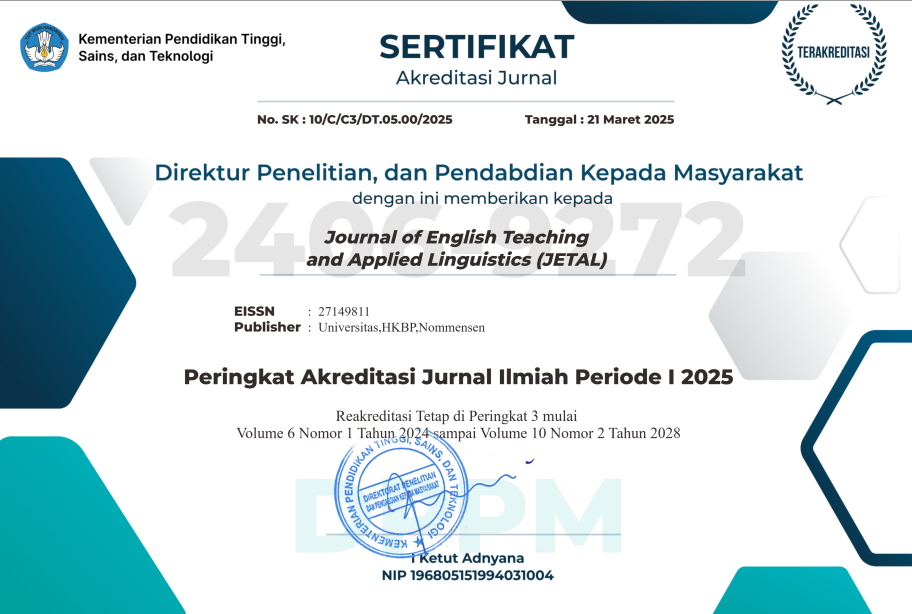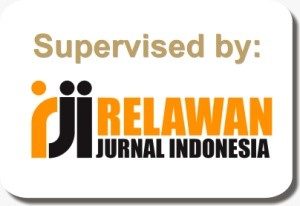Non-EFL Students' Ability in Writing Simple Sentences of Descriptive Paragraphs
Abstract
The objective of this study is to know the students’ ability in writing English simple sentences. This research is descriptive qualitative. The result shows that students have understanding of how to construct simple sentences in several formulas such as Subject + Verb + Complement (S + V + C), Subject + Verb + Adverb (S + V + Adv), Subject + Verb + Object (S + V + Object), and Subject + Verb + Object + Adverb (S + V + O + Adverb). But, besides using simple sentences, the students also still use other sentence forms to support information in their paragraphs such as 1) compound sentences by using the coordinating conjunction for example “so”, ”but”, and “and”. 2) complex sentence by using the coordinating conjunction for example “after”, “before”, “so that”, “if”, “that”, “because”, “even though”, “although”, “when, “while”. 3) compound-complex sentence by using both coordinating conjunction and subordinating conjunction”. Therefore, the teachers/lecturers need to give understanding more to the students that 1) a simple sentence has one independent clause and expresses one idea/topic. 2) simple sentence must have a subject-verb combination, but the subject can be compound or more than one. 3) simple sentence can have a compound verb. 4) simple sentences can only have one subject-verb combination and commas are not used. The students must be able to understand and know the subject, predicate (verb) and nouns, adjectives, and adverbs that will give a complete meaning. So that those who read will understand what they want to convey through the sentence.
References
Cogni, M. (2019). From Sentences to Essays: A Guide to Reflective Writing through Reflective Thinking: Student’s Edition. Vernon Press.
Datchuk, S. M., & Kubina, R. M. (2017). A Writing Intervention to Teach Simple Sentences and Descriptive Paragraphs to Adolescents with Writing Difficulties. Education and Treatment of Children, 40(3), 303–326. https://doi.org/10.1353/etc.2017.0013
Ehrenhaft, G. (2020). AP English Language and Composition Premium: With 8 Practice Tests. Simon and Schuster.
Embriany, F., Syarif, H., & Fitrawati, F. (2018). An Analysis of the Second Year Students’ Ability in Constructing Compound Sentences at English Department of Universitas Negeri Padang. Journal of English Language Teaching, 7(4), Article 4. https://doi.org/10.24036/jelt.v7i4.101492
Erickson, R. J. (2013). A Beginner’s Guide to New Testament Exegesis: Taking the Fear out of Critical Method. InterVarsity Press.
Fasano, T. (2015). Common Core Grammar: High School Edition. Coyote Canyon Press.
Fitria, T. N. (2019a). Errors in Students’ Writing Composition in Simple Present Tense “MY DAILY ACTIVITY.” EDULANGUE, 2(1), 47–62. https://doi.org/10.20414/edulangue.v2i1.318
Fitria, T. N. (2019b). Students’ Error Analysis in Writing English Composition of ‘My Self Description.’ Proceeding SENDI_U, 453–460.
Fitria, T. N. (2021). An Analysis of Regular and Irregular Verbs in Students Writing Essay. LLT Journal: A Journal on Language and Language Teaching, 24(1), 276–287. https://doi.org/10.24071/llt.v24i1.2595
Folse, K. S., Solomon, E. V., & Muchmore-Vokoun, A. (2020). Great Writing 1: Great Sentences for Great Paragraphs. Cengage Learning.
Graves, H., & Graves, R. (2011). A Strategic Guide to Technical Communication. Broadview Press.
Guffey, M. E., & Seefer, C. M. (2019). Business English. Cengage Learning.
Gupta, S. K., & Prakashan, G. B. (2018). Active English Grammar & Composition Class 7. Goyal Brothers Prakashan.
Gupta, S. M. (2019). Current English Grammar and Usage (Second Edition). PHI Learning Pvt. Ltd.
Hamaguchi, C. (2004). Power Practice: Traits of Good Writing, Gr. 6-8, eBook. Creative Teaching Press.
Hess, A. L. (2014). Diagramming Sentences: A Playful Way to Analyze Everyday Language. Amy Lynn Hess.
Istiqomah. (2021). An Analysis of Students’ Ability in Identifying Compound Complex Sentence at the Fourth Semester of English Education Study Program at UIN Raden Intan Lampung in Academic Year of 2019/2020 [Undergraduate Paper, UIN Raden Intan Lampung]. http://repository.radenintan.ac.id/13228/
Jonker, J., & Pennink, B. (2010). The Essence of Research Methodology: A Concise Guide for Master and PhD Students in Management Science. Springer Science & Business Media.
Kemper, D., Meyer, V., Rys, J. V., & Sebranek, P. (2018). Fusion: Integrated Reading and Writing, Book. Cengage Learning.
Lougheed, L. (2021). TOEFL IBT Writing (with Online Audio). Simon and Schuster.
Mathis, P. (2013). Blueprints for Writing: Building Essays. Cengage Learning.
Murray, K. (2013). Simple and Compound Sentences. The Rosen Publishing Group.
Nelson, G., & Nelson, P. G. (2001). English: An Essential Grammar. Psychology Press.
Rahma, A. A., & Rosa, R. N. (2021). An Analysis on Students’ Ability in Using Compound-Complex Sentences in Writing a Short Essay. Journal of English Language Teaching, 10(1), 53–60. https://doi.org/10.24036/jelt.v10i1.111378
Ria, A., Khairul, K., & Lely, R. (2020). An Analysis of the Second Year Students’ Ability in Writing Compound Sentences Using Correlative Conjunctions at EnglishDepartment of Bung Hatta University [Undergraduate Paper, Universitas Bung Hatta]. http://repo.bunghatta.ac.id/540/
Ruday, S. (2020). The Middle School Grammar Toolkit: Using Mentor Texts to Teach Standards-Based Language and Grammar in Grades 6–8. CRC Press.
Saddler, B., & Asaro-Saddler, K. (2009). Writing Better Sentences: Sentence-Combining Instruction in the Classroom. Preventing School Failure: Alternative Education for Children and Youth, 54(3), 159–163. https://doi.org/10.1080/10459880903495851
Saputra, N. A., & Munaf, Y. (2020). Perkembangan Peserta Didik. Deepublish.
Sari, I. D., Syarif, H., & Amri, Z. (2019). An Analysis of Compound Sentences in Students’ Writing. 341–348. https://doi.org/10.2991/icla-18.2019.57
Skocik, C. (2002). English Lesson Plans for Substitute Teachers. Walch Publishing.
Subekti, A. S. (2017). A Study of the Mastery of Complex Sentences of Pre-Service English Teachers. Ahmad Dahlan Journal of English Studies, 4(2), 1–12. https://doi.org/10.26555/adjes.v4i2.6399
Sullivan, N. M. (2020). Essential Grammar for Today’s Writers, Students, and Teachers. Routledge.
VanderMey, R., Meyer, V., Rys, J. V., & Sebranek, P. (2014). The College Writer: A Guide to Thinking, Writing, and Researching. Cengage Learning.
Verma, S. (2017). Common Errors in English. S. Chand Publishing.
Walter, J. (2016). Building Writing Skills the Hands-on Way. Cengage Learning.
Wyrick, J. (2017). Steps to Writing Well with APA 7e Updates. Cengage Learning.
Yusuf, M. (2016). Metode Penelitian Kuantitatif, Kualitatif & Penelitian Gabungan. Prenada Media.
Authors retain copyright and grant the journal right of first publication with the work simultaneously licensed under a Creative Commons Attribution-ShareAlike 4.0 International License (CC BY-SA 4.0) that allows others to share the work with an acknowledgment of the work's authorship and initial publication in this journal.
Authors are able to enter into separate, additional contractual arrangements for the non-exclusive distribution of the journal's published version of the work (e.g., post it to an institutional repository or publish it in a book), with an acknowledgment of its initial publication in this journal.
Authors are permitted and encouraged to post their work online (e.g., in institutional repositories or on their website) prior to and during the submission process, as it can lead to productive exchanges, as well as earlier and greater citation of published work (See The Effect of Open Access).






